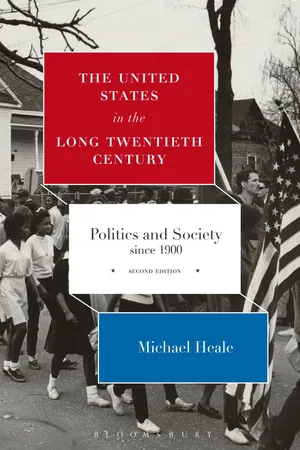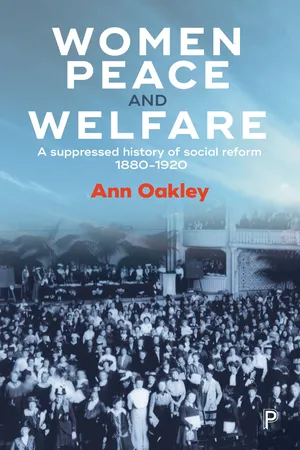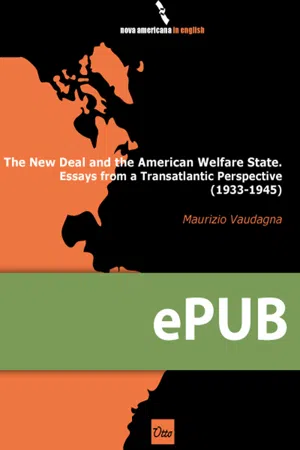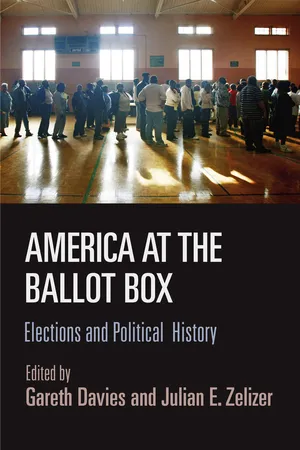History
Women and the New Deal
"Women and the New Deal" refers to the impact of the New Deal policies on women during the 1930s in the United States. The New Deal provided opportunities for women to enter the workforce through programs such as the Works Progress Administration and the Civilian Conservation Corps. It also addressed issues such as wage discrimination and labor rights, although some argue that the policies did not fully address the needs of women.
Written by Perlego with AI-assistance
Related key terms
1 of 5
6 Key excerpts on "Women and the New Deal"
- eBook - PDF
The United States in the Long Twentieth Century
Politics and Society since 1900
- Michael Heale(Author)
- 2014(Publication Date)
- Bloomsbury Academic(Publisher)
Further, as a welfare edifice was built, it came to be run primarily by men. Women had constituted 80 per cent of social workers in 1930; by 1940 the percentage had dropped to 65 per cent. The celebrated GI Bill of 1944 conferred yet further benefits on men, since only about 2 per cent of military personnel were women. The New Deal’s faith in the expert allowed no room for the spiritual contribution traditionally imparted by women. Yet some women did succeed in carving a niche in the New Deal Order. If jobs and political office proved elusive, some women’s groups threw themselves into a consumers’ movement which organized boycotts to contest high prices and lobbied government for greater regulation of food and other products. The women of the National Consumers’ League (NCL) helped to secure the Fair Labor Standards Act of 1938 (see Chapter 8). The activists of the older women’s reform network naturally gravitated towards Franklin Roosevelt’s Democratic Party, and the president’s wife Eleanor Roosevelt cherished her links with them and served as their eloquent spokesperson. Eleanor Roosevelt, who threw herself fearlessly into a range of causes, was a highly controversial and very public First Lady, and if many Americans did not fully appreciate her championship of women’s rights, her husband did. A responsive president appointed the first woman cabinet member and the first woman judge on the federal Circuit Court of Appeals. Further, women’s expertise was needed in the new welfare programmes. Roosevelt’s Secretary of Labor, Frances Perkins, had once participated in the settlement house movement and brought a deep knowledge of working conditions to the cabinet. From out of the black women’s club movement came Mary McLeod Bethune, Director of the Office of Negro Affairs. Another with social work experience was Molly Dewson, who developed a career within the Democratic Party, becoming the first full-time director of its women’s division. - eBook - ePub
Women, Peace and Welfare
A Suppressed History of Social Reform, 1880-1920
- Ann Oakley, Oakley, Ann(Authors)
- 2018(Publication Date)
- Policy Press(Publisher)
ELEVENNew deals: women reformers in the 1920s and 1930s
It was February, 1933. Franklin Roosevelt had recently been elected President of the United States. A woman with whom he had worked, and whom he had known for over 20 years, was coming to see him at his home in Hyde Park, New York, a lavish Italianate mansion which he had remodelled in colonial revival style. Roosevelt drove Frances Perkins around the Hyde Park estate in his hand-operated automobile – necessary because of the damage polio had inflicted on him. He pointed out the new trees and other improvements, of which he was very proud, and they discussed the grave industrial and social problems of the US and what might be done to solve them. She knew that he wanted her to be his new Secretary of Labor, the first female member of a presidential cabinet, but he didn’t know just what she intended to accomplish in such an important political position. She told him. The package included unemployment insurance, old age insurance and health insurance. ‘I remember he looked so startled, and he said, “Well, do you think it can be done?”’ She told him she didn’t know, but she wanted to try. She wanted his authorization. He gave it. She could try. And that was how it all began.1In so far as the US has ever had a welfare state, most of the credit for its federal legislative origins should go to Frances Perkins. She served as Secretary of Labor from 1933 to 1945, during all four of Franklin Roosevelt’s administrations, and was directly behind most of the social legislation associated with what is known as ‘the New Deal’ era in the US. Behind her were the achievements of many of the women reformers who appear in this book. Through her, the sociology of Settlement women that emphasized the need for evidence-based federal government action to promote social justice came to inform government values and policies. But, while we remember Franklin Roosevelt, most of us have never heard of Frances Perkins: her role as the principal architect of the New Deal is missing from most histories of that time. Because we don’t know who she was or what she did, we are also excluded from knowing about the history that connects her to the transnational networks of women reformers who developed the tools of social science and a shared commitment to a just public policy. In being forgotten, Frances Perkins joins a large contingent of other women reformers. Her accomplishments, like theirs, once excavated, provide some kind of answer to the question: what difference did the women make? This chapter looks at how the work of women reformers bore fruit and continued into the 1920s and 1930s and beyond. Their labours and their ideas formed a living tradition, and can’t simply be treated as a short-lived moment in social history. - eBook - PDF
- Jane Kamensky, Carol Sheriff, David W. Blight, Howard Chudacoff(Authors)
- 2018(Publication Date)
- Cengage Learning EMEA(Publisher)
Due to electronic rights, some third party content may be suppressed from the eBook and/or eChapter(s). Editorial review has deemed that any suppressed content does not materially affect the overall learning experience. Cengage Learning reserves the right to remove additional content at any time if subsequent rights restrictions require it. 22-2 Franklin D. Roosevelt and the Launching of the New Deal 641 Table 22.1 New Deal Achievements Year Labor Agriculture and Environment Business and Industrial Recovery Relief Reform 1933 Section 7(a) of NIRA Agricultural Adjustment Act Farm Credit Act Emergency Banking Relief Act Economy Act Beer-Wine Revenue Act Banking Act of 1933 (guaranteed deposits) National Industrial Recovery Act Civilian Conservation Corps Federal Emergency Relief Act Home Owners Refinancing Act Public Works Administration Civil Works Administration TVA Federal Securities Act 1934 National Labor Relations Board Taylor Grazing Act Securities Exchange Act Reciprocal Trade Agreements Act Export-Import Bank 1935 National Labor Relations (Wagner) Act Resettlement Administration Rural Electrification Administration Works Progress Administration National Youth Administration Social Security Act Public Utility Holding Company Act Revenue Act (wealth tax) 1937 Farm Security Administration National Housing Act 1938 Fair Labor Standards Act Agricultural Adjustment Act of 1938 Source: Adapted from Charles Sellers, Henry May, and Neil R. McMillen, A Synopsis of American History, 6th ed. Copyright © 1985 by Houghton Mifflin Company. Reprinted by permission. Work relief programs rarely addressed the needs of poor women. Mothers of young children were usually classified as “unemployable” and were offered relief instead of jobs. But in North Carolina, for example, the “mother’s-aid” grant was one-sixth of the wage paid in a federal works program. - Elizabeth Cobbs, Edward Blum, Jon Gjerde, , Elizabeth Cobbs, Edward Blum, Jon Gjerde(Authors)
- 2016(Publication Date)
- Cengage Learning EMEA(Publisher)
Its cardinal aim was not to destroy capitalism but to devolatilize it, and at the same time to distribute its benefits more evenly … . … And ever after, Americans assumed that the federal government had not merely a role, but a major responsibility, in ensuring the health of the economy and the welfare of citizens. That simple but momentous shift in perception was the newest thing in all the New Deal, and the most consequential too. Humankind, of course, does not live by bread alone. Any assessment of what the New Deal did would be incomplete if it rested with an appraisal of New Deal economic policies and failed to acknowledge the remarkable array of social inno-vations nourished by Roosevelt ’ s expansive temperament … . THE DEPRESSION, THE NEW DEAL, AND FRANKLIN D. ROOSEVELT 243 Copyright 2017 Cengage Learning. All Rights Reserved. May not be copied, scanned, or duplicated, in whole or in part. Due to electronic rights, some third party content may be suppressed from the eBook and/or eChapter(s). Editorial review has deemed that any suppressed content does not materially affect the overall learning experience. Cengage Learning reserves the right to remove additional content at any time if subsequent rights restrictions require it. For all his alleged inscrutability, Franklin Roosevelt ’ s social vision was clear enough. “ We are going to make a country, ” he once said to Frances Perkins, “ in which no one is left out. ” In that unadorned sentence Roosevelt spoke volumes about the New Deal ’ s lasting historical meaning. Like his rambling, comfortable, and unpretentious old home on the bluff above the Hudson River, Roosevelt ’ s New Deal was a welcoming mansion of many rooms, a place where millions of his fellow citizens could find at last a measure of the security that the patrician Roosevelts enjoyed as their birthright.- eBook - PDF
- Maurizio Vaudagna(Author)
- 2014(Publication Date)
- Otto(Publisher)
49 I tried to address the interaction between the domestic and international contexts on the one hand and the New Deal and the war years on the other in my essay “Social Protection and the Promise of a Secure Future in Wartime Europe and America,” in Defining the Atlantic Community. Culture, Intellectuals, and Politics in the Mid-Twentieth Century , ed. Marco Mariano (London, 2010), 91-110. 30 The New Deal aND The americaN welfare STaTe The Last Decade and Transnational American History The publishing of books on the New Deal has continued unabated since the beginning of the new millennium, pushed forward by the powerful PhD-producing machine, the massive number of modern American historians and the appeal of one of the decisive turning points in the history of the twentieth century. However, it would be hard to claim that the New Deal has been at the center of the most lively debates of the last thirty years in American history addressing social and gender history, the cultural turn and the revival of political history. Since the start of the twenty-first century, both scholarly and popular narratives on 1930s America have appeared in huge numbers. The field has also segmented, with important new studies on environmental history, the history of popular culture, women’s history and black history, in addition to more traditional subfields. Perhaps we could divide these works into analyses of the overall social conditions of the Depression decade on the one hand and those that have mostly focused on government policies and their protagonists on the other hand, though the distinction is still rather raw. 50 The fact that the 2008 economic slump inaugurated a new “Great Depression” largely explains this lively comeback of interest in the 1930s. - eBook - ePub
America at the Ballot Box
Elections and Political History
- Gareth Davies, Julian E. Zelizer, Gareth Davies, Julian E. Zelizer(Authors)
- 2015(Publication Date)
- University of Pennsylvania Press(Publisher)
For some, the failure of the New Deal to achieve its more social democratic aspirations—for economic planning, labor regulation, social provision—was portentous, ensuring that politics during the 1940s and 1950s (or even beyond) would have a constricted, complacent character, and that the fundamental problems of American democracy and American capitalism would go unattended. To the extent that the New Deal yielded an enduring political era, it is notable primarily for its limits. 1 For other historians, the New Deal break with the nation’s antistatist past was more impressive: it was during the Depression decade that Americans came, however uneasily, to look to government to protect them from adversity, and this constituted a historic change in political culture. According to this view, all presidents during the post–World War II era, Republican as well as Democrat, conservative as well as liberal, lived “in the shadow of FDR,” and the new legitimacy of the state, this new habit of looking to Washington for help, constituted the lasting and vitally important consequence of the New Deal. 2 That the emergency of the Great Depression should have been followed in such short order by World War II and the Cold War complicates one’s task in attempting to characterize the distinct legacy of the New Deal. How does one separate out the respective contributions of reform politics and national security politics to American state building during the middle decades of the twentieth century? In statistical terms, the answer is straightforward: government spending, tax revenues, and the federal workforce all grew significantly during the 1930s, but they then increased massively during World War II, and those increases were maintained during the early Cold War period
Index pages curate the most relevant extracts from our library of academic textbooks. They’ve been created using an in-house natural language model (NLM), each adding context and meaning to key research topics.





